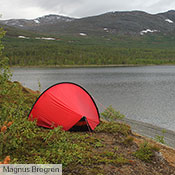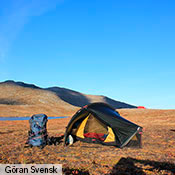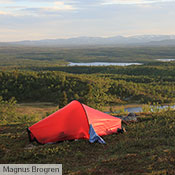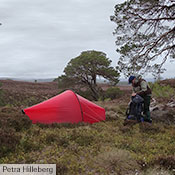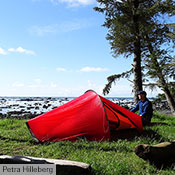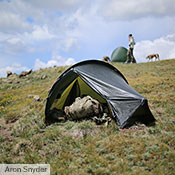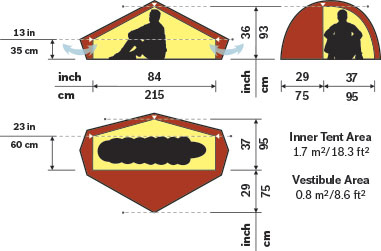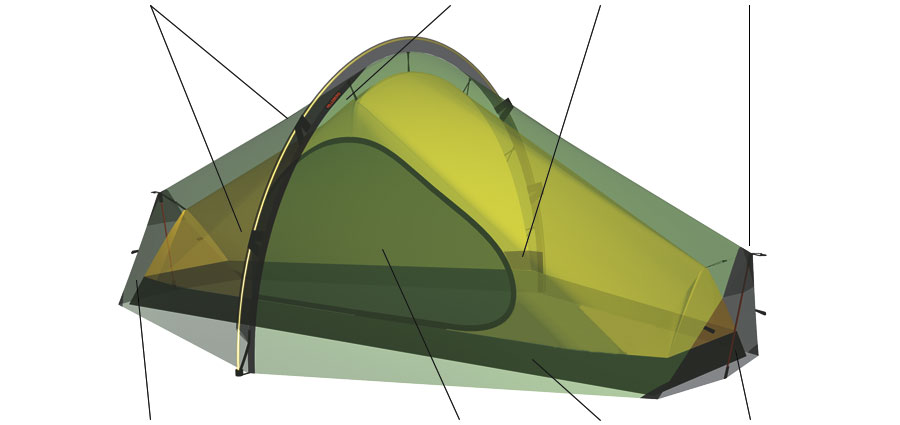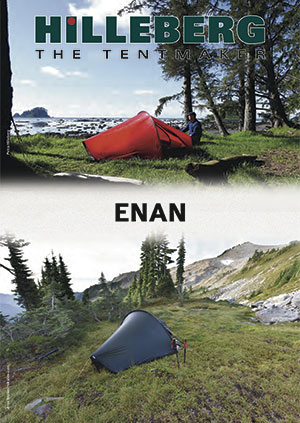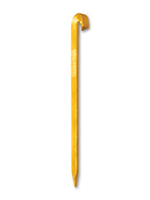At first glance, our Enan solo tent looks remarkably like our all-season Red Label Akto. And, indeed, we modeled the Enan, which we introduced in 2015, on the Akto, which we debuted in 1995.
In its 20 years, the iconic Akto has more than proven itself. Hikers, cyclists, climbers, paddlers, and hunters continue to count on it in a wide array of all-season conditions and terrains. “It has even been used quite successfully on North and South Pole expeditions,” says Bo Hilleberg, company founder and chief of product development. “But this is not really something we recommend!”
So when we began envisioning a very light Yellow Label solo tent, it made perfect sense to choose our Akto’s proven design as a starting place. As Bo points out, however, “the Enan is much more than simply a lighter weight Yellow Label ‘version’ of the Akto.”
When we began developing our Yellow Label, three-season tent line in 2010, we had been making all-season tents for over 35 years. From that long experience, we knew that the term “three season” could vary wildly depending on location. So we designed our first Yellow Label tents to be very light, yet strong enough for use during the snow-free months of the year, in fairly protected conditions, but completely independent of geographic locale.
With the Enan, our goal was to create a roomy one-person tent that fulfilled our “snow-free adventure” concept. All Yellow Label tents are designed to be very light and strong, and the Enan is no exception: we wanted to make it as light as possible for its intended use, but with all the requisite strength for the conditions needed for its intended use.
We began with our Kerlon 1000 outer tent fabric, the same as we use in our Anjan and Rogen models. We also developed a new, lighter weight inner tent fabric and a lighter weight mesh. Next we considered how else we could create weight savings. In keeping with the Enan’s snow-free use, we wanted to pare down the original Akto design, but without losing any function. The result is the triangular ends, which, according to Bo, save “a notable amount of weight.” We also “3-seasoned” the Akto’s head and foot ends, which are made from a breathable and air-permeable snow proof fabric. For the Enan version, we used full mesh for constant air flow, and then built in stowable flaps that can be deployed in the worst rainy conditions. And, as with all Yellow Label tents, fixed mesh panels on the inner tent make venting a full-time affair. “The end result,” says Bo, “is exactly what we wanted – a very light yet quite strong and roomy solo tent.”
Since its introduction a year ago, the Enan, like its Red Label sibling, the Akto, has proven itself a tough and versatile solo tent. We’ve heard from a great deal of users who have had great success with the Enan in a variety of conditions – including some that definitely push the limits of what the Enan was designed for. And we were honored that Germany’s largest outdoor magazine, Outdoor, awarded the Enan its prestigious Editor’s Choice award in the summer of 2015.
At first glance, our Enan solo tent looks remarkably like our all-season Red Label Akto. And, indeed, we modeled the Enan, which we introduced in 2015, on the Akto, which we debuted in 1995.
In its 20 years, the iconic Akto has more than proven itself. Hikers, cyclists, climbers, paddlers, and hunters continue to count on it in a wide array of all-season conditions and terrains. “It has even been used quite successfully on North and South Pole expeditions,” says Bo Hilleberg, company founder and chief of product development. “But this is not really something we recommend!”
So when we began envisioning a very light Yellow Label solo tent, it made perfect sense to choose our Akto’s proven design as a starting place. As Bo points out, however, “the Enan is much more than simply a lighter weight Yellow Label ‘version’ of the Akto.”
When we began developing our Yellow Label, three-season tent line in 2010, we had been making all-season tents for over 35 years. From that long experience, we knew that the term “three season” could vary wildly depending on location. So we designed our first Yellow Label tents to be very light, yet strong enough for use during the snow-free months of the year, in fairly protected conditions, but completely independent of geographic locale.
With the Enan, our goal was to create a roomy one-person tent that fulfilled our “snow-free adventure” concept. All Yellow Label tents are designed to be very light and strong, and the Enan is no exception: we wanted to make it as light as possible for its intended use, but with all the requisite strength for the conditions needed for its intended use.
We began with our Kerlon 1000 outer tent fabric, the same as we use in our Anjan and Rogen models. We also developed a new, lighter weight inner tent fabric and a lighter weight mesh. Next we considered how else we could create weight savings. In keeping with the Enan’s snow-free use, we wanted to pare down the original Akto design, but without losing any function. The result is the triangular ends, which, according to Bo, save “a notable amount of weight.” We also “3-seasoned” the Akto’s head and foot ends, which are made from a breathable and air-permeable snow proof fabric. For the Enan version, we used full mesh for constant air flow, and then built in stowable flaps that can be deployed in the worst rainy conditions. And, as with all Yellow Label tents, fixed mesh panels on the inner tent make venting a full-time affair. “The end result,” says Bo, “is exactly what we wanted – a very light yet quite strong and roomy solo tent.”
Since its introduction a year ago, the Enan, like its Red Label sibling, the Akto, has proven itself a tough and versatile solo tent. We’ve heard from a great deal of users who have had great success with the Enan in a variety of conditions – including some that definitely push the limits of what the Enan was designed for. And we were honored that Germany’s largest outdoor magazine, Outdoor, awarded the Enan its prestigious Editor’s Choice award in the summer of 2015.

 Cart
Cart










